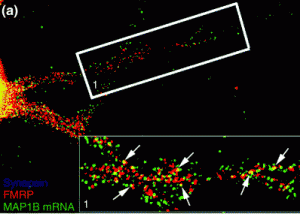If the brain acts like a computer, which of the brain’s physical features store the information? Flashes of electricity may keep memories and sensations alive for the moment, but what plays the role that hard drives and CDs do for computers?
A simple answer could be: genes turning on and off, and eventually, neurons growing and changing their shapes. But it gets more complicated pretty quickly. Genes can be regulated at several levels:
- at the level of transcription — whether messenger RNA gets made from a stretch of DNA in the cell’s nucleus
- at the level of translation — whether the messenger RNA is allowed to make a protein
- at the level of RNA localization — where the mRNAs travel within the cell
Each neuron has only two copies of a given gene but will have many dendrites that can have more or less RNA in them. That means the last two modes of regulation offer neurons much more capacity for storing information.
Gary Bassell, a cell biologist at Emory, and his colleagues have been exploring how RNA regulation works in neurons. They have developed special tools for mapping RNA, and especially, microRNA — a form of RNA that regulates other RNAs.

In the dendrites of neurons, FMRP seems to control where RNAs end up
Fragile X mental retardation protein (FMRP), linked to the most common inherited form of mental retardation, appears to orchestrate RNA traffic in neurons. Bassell and pharmacologist Yue Feng recently received a grant from the National Institute of Child Health and Development to study FMRP’s regulation of RNA in greater detail. The grant was one of several at Emory funded through the American Recovery and Reinvestment Act’s support for the NIH.
In the video interview above, Bassell explains his work on microRNAs in neurons. Below is a microscope image, provided by Bassell, showing the pattern of FMRP’s localization in neurons.




